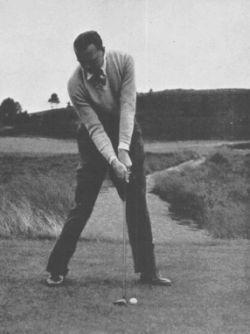This is the 3rd instalment of the preparatory movements for the golf swing. I should have published this entry last weekend, but a "series of unfortunate events" prevented me from doing so.
No, it was nothing serious, just a lot of work in my 9 to 5 and an unexpected cold that lasted for 4 days making it very difficult to concentrate on just about anything.
But I'm back on my feet now, and this discussion continues where we left it at.
I know I said this was going to be divided into 3 parts. That was due to a miscalculation from my part and, rather than making this part rather long, I decided to split it into 2 more parts.
"One sensation for all shots." I keep harping on this because it is not the knowledge of what we have to do which leaves us on the course it is the feel of what we want to do that is apt to evaporate unless we have built up a secure feel-memory of how the swing operates.
The only way in which we can repeat correct shots time after time (and this is the greatest of golfing assets ) is to be able to repeat the correct feel of how they are produced.
This feel must begin right as well as continue and finish right, and that is why I have gone into such detail in the apparently simple matter of standing in front of the ball.
Now I do not suggest that you will get this properly braced feeling at once, or that you cannot play good golf until you do get it.
My experience is that few beginners brace well, except mechanically.
One pupil of mine who had made marvellous progress only fully realized the conception of bracing after two years when he was
already capable of an occasional 78.
We knew, when he did realize it, that the 78's would now become more frequent because he would begin to re¬peat his best shots more often.
It is always a pleasure to teach intelligent analytically-minded players who think about their game, even if they are physically not
capable of playing high-class golf.
I remember a lady whose game had been largely messed up because to "cure" a somewhat persistent slice someone had told her to draw her right foot back a bit and hold her right hip back.
Well, I squared up her stance and showed her how to brace and she began sweeping the ball away so perfectly that she could hardly believe her eyes!
The next day she came back and told me she had thought over what I had told her and had found a curious resemblance between my "hip brace" and something that Miss Irene Castle the dancer had said to her some years before.
"Do you know," she said, "that while studying the dancing of Egyptians from old illustrations, Miss Castle found that they did not dance with their feet and hips and shoulders square, but with the hips profiled to the other two lines, and Miss Castle put down much of her success as a dancer to the fact that she adopted this idea?"
Now that was exceedingly interesting to me, even if it did upset some of the reasons I had worked out for the hips being "profiled" at golf.
Like most of those who had been lucky enough to see Miss Castle dance, I had wondered how she did itand here was part of the answer.
I am more than ever convinced that the correct bracing of the body in this way is as essential to good golf as it is helpful to good dancing and that it is something that we should all seek for whatever our caliber.
I remember playing with Lord Derby and, because of his rotund figure, reminding him of the old Scotch golf adage I had heard from Sandy Herd when I was a boy. "Pull in your tummy, my Lord," I said.
He looked at me and smiled. "Do you think I am Miss Wethered?" he said! At that time Miss Wethered was a slim girl, at the peak of
her perfection as a golfer.
As with many other ideas which have come recently to the front, now that we know more about the brace, we find traces of it going way
back into history!
POINTS TO STUDY
One of the finest pictures I have ever seen of a golfer standing to the ball was one of Mac Smith reproduced in the American Golfer some years ago, to my mind a perfect illustration of the correct set.
I have it in my scrapbook and often take a peep at it, for we cannot refresh our memories too often.
Study the photograph of Aubrey addressing the ball bellow.
Note especially the close relationship between this set and the actual hitting
position; there is almost no difference between them, and that is why the good golfer can feel his drive in his address.

- The stance is firm, compact, and braced, qualities essential to a fast swinger.
- Note the triangle formed by the two arms and the shoulders.
- Although the right wrist is held arched (that is, up), the right elbow is held in and down.
- Note the inclination of the shoulders, due to the left side being straight and the right side curved.
- The right elbow is inside the right hip. The left arm and club are in line.
- The shoulders and feet are square to the line of flight, the hips are profiled that is, are at a slight angle to it.
- The view of the ball from this position is a peeping at the back of the ball out of the left eye.



